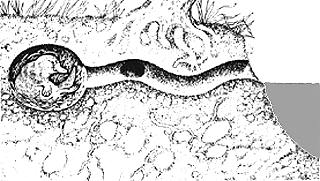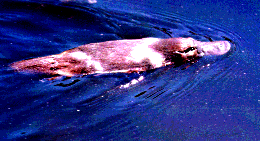The
platypus
is found in all freshwater creeks, rivers, and lakes
of eastern Australia from the Cooktown area in the
north to Tasmania in the south. It can be found
in 26 of 31 river systems in Victoria.
Platypuses like long pools with solid angled banks,
slow flowing water, pool depths of one to two meters,
plenty of aquatic vegetation, and a good quantity
of water-dwelling invertebrates.
The
platypus is protected by law throughout
Australia. Even though it is common in
Australia, it is considered vulnerable due to the
continuing loss of its natural habitat due to damming,
drainage, and pollution. The population of
platypuses has declined in areas close to Melbourne
due to human population growth.
 The
platypus makes two kinds of burrows. The camping
burrow is used by both sexes as a living space except
in the breeding season, when it is used as a bachelor
apartment. This burrow is usually semicircular
with entrances at each end concealed by overhanging
ledges. These burrows are often found behind
tree roots. The other burrow, a nesting burrow,
is dug by the mother for breeding. She then adds
a "nursery" or nesting chamber. The passage
conforms to her shape and is sloped up as a protection
against floods. The entrance is always above
water. She may build her nest with gum leaves,
thin willow twigs, or reeds crushed by her bony
jaws. To create ideal brooding conditions, the
mother platypus plugs the burrow behind her at several
intervals with walls of earth. These plugs help
resist flooding and offer some safety from potential
enemies. Platypuses usually preen and squeeze
water from their fur before entering their burrow to
keep the burrow as dry as possible.
The
platypus makes two kinds of burrows. The camping
burrow is used by both sexes as a living space except
in the breeding season, when it is used as a bachelor
apartment. This burrow is usually semicircular
with entrances at each end concealed by overhanging
ledges. These burrows are often found behind
tree roots. The other burrow, a nesting burrow,
is dug by the mother for breeding. She then adds
a "nursery" or nesting chamber. The passage
conforms to her shape and is sloped up as a protection
against floods. The entrance is always above
water. She may build her nest with gum leaves,
thin willow twigs, or reeds crushed by her bony
jaws. To create ideal brooding conditions, the
mother platypus plugs the burrow behind her at several
intervals with walls of earth. These plugs help
resist flooding and offer some safety from potential
enemies. Platypuses usually preen and squeeze
water from their fur before entering their burrow to
keep the burrow as dry as possible.
 Throughout the year the platypus must adapt to changes
in temperature both on land and in the water. In
the winter the air can be a minimum temperature of -12
degrees Celsius and the water can be a minimum
temperature of 0 degrees Celsius. In the summer the
maximum air temperature can be 34 degrees Celsius and
the maximum water temperature can be 24 degrees
Celsius. Even the temperature in the burrow can
be a minimum of 14 degrees Celsius in the winter and a
maximum of 18 degrees Celsius in the summer. The
platypus adapts in a variety of ways to these
temperature changes. As the temperature drops,
the platypus generates more heat to maintain its
normal body temperature. It does this by
increasing its metabolism. This increase
requires more energy which requires more food to be
consumed. This is when the fat stored in the
tail can be used if not enough food can be
found. The platypus uses its blood circulation
to carry heat to the parts of the body that require it
and it reduces the circulation to its hind legs, tail,
and bill which do not need as much. Its dense,
waterproof fur also traps a layer of air which
provides good insulation against the cold. In
southeastern Australia the platypus has short periods
of hibernation or semi hibernation. These
hibernation periods are short and irregular during the
cooler months with the longest single recorded period
being 6.5 days.
Throughout the year the platypus must adapt to changes
in temperature both on land and in the water. In
the winter the air can be a minimum temperature of -12
degrees Celsius and the water can be a minimum
temperature of 0 degrees Celsius. In the summer the
maximum air temperature can be 34 degrees Celsius and
the maximum water temperature can be 24 degrees
Celsius. Even the temperature in the burrow can
be a minimum of 14 degrees Celsius in the winter and a
maximum of 18 degrees Celsius in the summer. The
platypus adapts in a variety of ways to these
temperature changes. As the temperature drops,
the platypus generates more heat to maintain its
normal body temperature. It does this by
increasing its metabolism. This increase
requires more energy which requires more food to be
consumed. This is when the fat stored in the
tail can be used if not enough food can be
found. The platypus uses its blood circulation
to carry heat to the parts of the body that require it
and it reduces the circulation to its hind legs, tail,
and bill which do not need as much. Its dense,
waterproof fur also traps a layer of air which
provides good insulation against the cold. In
southeastern Australia the platypus has short periods
of hibernation or semi hibernation. These
hibernation periods are short and irregular during the
cooler months with the longest single recorded period
being 6.5 days.
|




